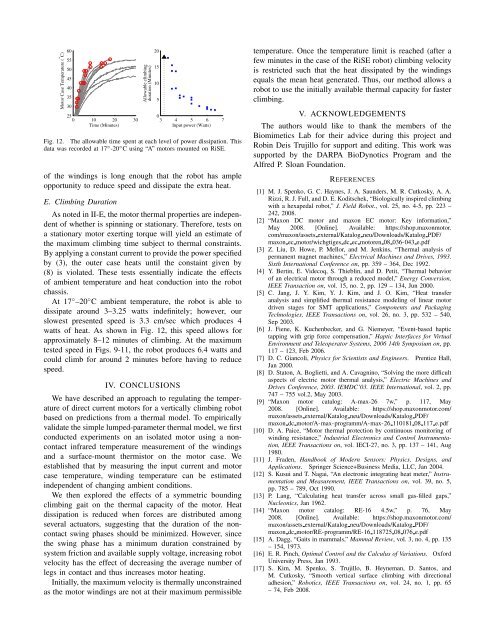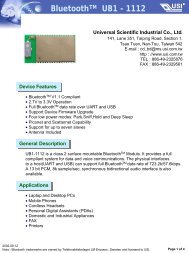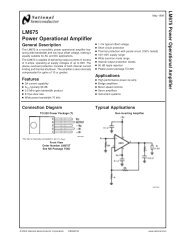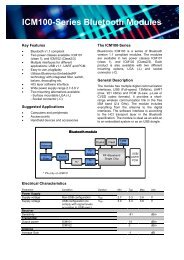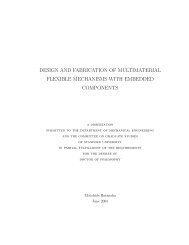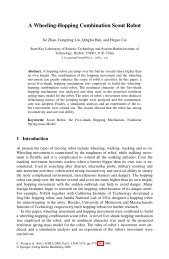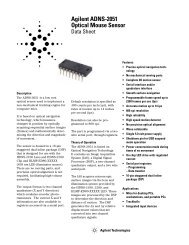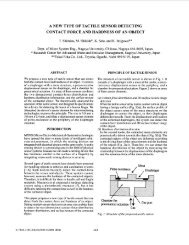Thermally Constrained Motor Operation for a Climbing Robot
Thermally Constrained Motor Operation for a Climbing Robot
Thermally Constrained Motor Operation for a Climbing Robot
Create successful ePaper yourself
Turn your PDF publications into a flip-book with our unique Google optimized e-Paper software.
<strong>Motor</strong> Case Temperature ( ° C)60555045403530250 10 20 30Time (Minutes)Allowable climbingduration (Minutes)201510503 4 5 6 7Input power (Watts)Fig. 12. The allowable time spent at each level of power dissipation. Thisdata was recorded at 17 ◦ -20 ◦ C using “A” motors mounted on RiSE.of the windings is long enough that the robot has ampleopportunity to reduce speed and dissipate the extra heat.E. <strong>Climbing</strong> DurationAs noted in II-E, the motor thermal properties are independentof whether is spinning or stationary. There<strong>for</strong>e, tests ona stationary motor exerting torque will yield an estimate ofthe maximum climbing time subject to thermal constraints.By applying a constant current to provide the power specifiedby (3), the outer case heats until the constaint given by(8) is violated. These tests essentially indicate the effectsof ambient temperature and heat conduction into the robotchassis.At 17 ◦ –20 ◦ C ambient temperature, the robot is able todissipate around 3–3.25 watts indefinitely; however, ourslowest presented speed is 3.3 cm/sec which produces 4watts of heat. As shown in Fig. 12, this speed allows <strong>for</strong>approximately 8–12 minutes of climbing. At the maximumtested speed in Figs. 9-11, the robot produces 6.4 watts andcould climb <strong>for</strong> around 2 minutes be<strong>for</strong>e having to reducespeed.IV. CONCLUSIONSWe have described an approach to regulating the temperatureof direct current motors <strong>for</strong> a vertically climbing robotbased on predictions from a thermal model. To empiricallyvalidate the simple lumped-parameter thermal model, we firstconducted experiments on an isolated motor using a noncontactinfrared temperature measurement of the windingsand a surface-mount thermistor on the motor case. Weestablished that by measuring the input current and motorcase temperature, winding temperature can be estimatedindependent of changing ambient conditions.We then explored the effects of a symmetric boundingclimbing gait on the thermal capacity of the motor. Heatdissipation is reduced when <strong>for</strong>ces are distributed amongseveral actuators, suggesting that the duration of the noncontactswing phases should be minimized. However, sincethe swing phase has a minimum duration constrained bysystem friction and available supply voltage, increasing robotvelocity has the effect of decreasing the average number oflegs in contact and thus increases motor heating.Initially, the maximum velocity is thermally unconstrainedas the motor windings are not at their maximum permissibletemperature. Once the temperature limit is reached (after afew minutes in the case of the RiSE robot) climbing velocityis restricted such that the heat dissipated by the windingsequals the mean heat generated. Thus, our method allows arobot to use the initially available thermal capacity <strong>for</strong> fasterclimbing.V. ACKNOWLEDGEMENTSThe authors would like to thank the members of theBiomimetics Lab <strong>for</strong> their advice during this project andRobin Deis Trujillo <strong>for</strong> support and editing. This work wassupported by the DARPA BioDynotics Program and theAlfred P. Sloan Foundation.REFERENCES[1] M. J. Spenko, G. C. Haynes, J. A. Saunders, M. R. Cutkosky, A. A.Rizzi, R. J. Full, and D. E. Koditschek, “Biologically inspired climbingwith a hexapedal robot,” J. Field <strong>Robot</strong>., vol. 25, no. 4-5, pp. 223 –242, 2008.[2] “Maxon DC motor and maxon EC motor: Key in<strong>for</strong>mation,”May 2008. [Online]. Available: https://shop.maxonmotor.com/maxon/assets external/Katalog neu/Downloads/Katalog PDF/maxon ec motor/wichgtiges dc ec motoren 08 036-043 e.pdf[3] Z. Liu, D. Howe, P. Mellor, and M. Jenkins, “Thermal analysis ofpermanent magnet machines,” Electrical Machines and Drives, 1993.Sixth International Conference on, pp. 359 – 364, Dec 1992.[4] Y. Bertin, E. Videcoq, S. Thieblin, and D. Petit, “Thermal behaviorof an electrical motor through a reduced model,” Energy Conversion,IEEE Transaction on, vol. 15, no. 2, pp. 129 – 134, Jun 2000.[5] C. Jang, J. Y. Kim, Y. J. Kim, and J. O. Kim, “Heat transferanalysis and simplified thermal resistance modeling of linear motordriven stages <strong>for</strong> SMT applications,” Components and PackagingTechnologies, IEEE Transactions on, vol. 26, no. 3, pp. 532 – 540,Sep 2003.[6] J. Fiene, K. Kuchenbecker, and G. Niemeyer, “Event-based haptictapping with grip <strong>for</strong>ce compensation,” Haptic Interfaces <strong>for</strong> VirtualEnvironment and Teleoperator Systems, 2006 14th Symposium on, pp.117 – 123, Feb 2006.[7] D. C. Giancoli, Physics <strong>for</strong> Scientists and Engineers. Prentice Hall,Jan 2000.[8] D. Staton, A. Boglietti, and A. Cavagnino, “Solving the more difficultaspects of electric motor thermal analysis,” Electric Machines andDrives Conference, 2003. IEMDC’03. IEEE International, vol. 2, pp.747 – 755 vol.2, May 2003.[9] “Maxon motor catalog: A-max-26 7w,” p. 117, May2008. [Online]. Available: https://shop.maxonmotor.com/maxon/assets external/Katalog neu/Downloads/Katalog PDF/maxon dc motor/A-max-programm/A-max-26 110181 08 117 e.pdf[10] D. A. Paice, “<strong>Motor</strong> thermal protection by continuous monitoring ofwinding resistance,” Industrial Electronics and Control Instrumentation,IEEE Transactions on, vol. IECI-27, no. 3, pp. 137 – 141, Aug1980.[11] J. Fraden, Handbook of Modern Sensors: Physics, Designs, andApplications. Springer Science+Business Media, LLC, Jan 2004.[12] S. Kusui and T. Nagai, “An electronic integrating heat meter,” Instrumentationand Measurement, IEEE Transactions on, vol. 39, no. 5,pp. 785 – 789, Oct 1990.[13] P. Lang, “Calculating heat transfer across small gas-filled gaps,”Nucleonics, Jan 1962.[14] “Maxon motor catalog: RE-16 4.5w,” p. 76, May2008. [Online]. Available: https://shop.maxonmotor.com/maxon/assets external/Katalog neu/Downloads/Katalog PDF/maxon dc motor/RE-programm/RE-16 118725 08 076 e.pdf[15] A. Dagg, “Gaits in mammals,” Mammal Review, vol. 3, no. 4, pp. 135– 154, 1973.[16] E. R. Pinch, Optimal Control and the Calculus of Variations. Ox<strong>for</strong>dUniversity Press, Jan 1993.[17] S. Kim, M. Spenko, S. Trujillo, B. Heyneman, D. Santos, andM. Cutkosky, “Smooth vertical surface climbing with directionaladhesion,” <strong>Robot</strong>ics, IEEE Transactions on, vol. 24, no. 1, pp. 65– 74, Feb 2008.


